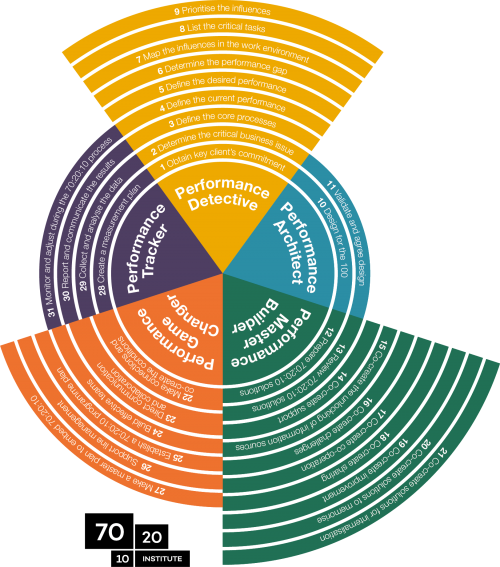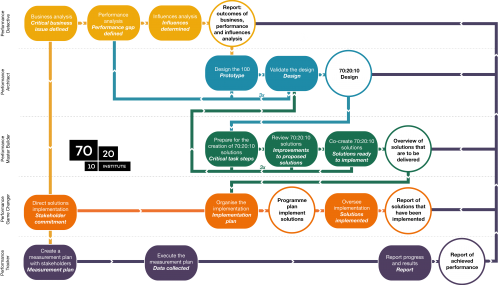The 70:20:10 Methodology For Learning And Development
Competency models and competency management play an important role in the world of Learning and Development. This is often based on the idea that there is a positive relationship between competencies and organizational results. Part 1 of this series of articles focuses on the value and limitations of a competency model for L&D. These models are intended to describe the ‘what’ of work, which is valuable but also insufficient. The ‘how’ of Learning and Development is also important, and is described in a methodology. Part 2 focuses on the methods used in work, and part 3 on the 70:20:10 methodology.
From 10 To 70:20:10
It is clear that learning in organizations extends beyond formal methods. For many professionals, it is logical that continuous development throughout their working careers is essential if they are to improve their performance.
Formal learning solutions such as training, eLearning or coaching (10) are simply not enough. Professionals learn mostly by working together (20 and 70). Yet reviews and research (Towards Maturity, 2017) report that formal learning solutions are still the principal offering from L&D .
Although there are many formal learning solutions (10) with added social learning (20),, this approach is not to be confused with 70:20:10.In these cases, the 20 is designed to be part of formal learning solutions. We refer to this as a 10+ approach.
The same applies to workplace assignments that are designed within formal learning to add observation, reflection or experimentation in the workplace. This is also a 10+ approach because the design adds workplace practice to formal learning.
With 70:20:10, it is important to start by identifying the desired organizational results, followed by a process based on reasoning back from those results and to design solutions utilizing 70, 20 and 10 approaches, in that order.
70:20:10 solutions need to be consistent with the core business objectives of organizations, to focus on performance outcomes. To achieve this, it is necessary for L&D to adopt new roles and new approaches.
These new roles and new processes form the basis of the 70:20:10 methodology.
Reason For The Development Of The 70:20:10 Methodology
For most professionals, working and learning are connected in a natural way. At least, they understand their development is not limited to the formal learning they undertake.
By working, people learn (often unconsciously) to solve problems, to collaborate, to sustainably improve, to renew, and so on.
For L&D, the challenge this presents is how to support workers within their workflow and not to restrict the L&D role to exclusively offering formal learning solutions.
The 70:20:10 methodology has been developed to enable expansion and renewal of L&D services so professionals and organizations are supported to learn and perform at the speed of business. That is, learning by working and not limited to (primarily or exclusively) formal learning solutions.
In addition, the 70:20:10 methodology moves beyond the competence models for L&D, as a standardized method. The 70:20:10 methodology clearly states how to act to achieve results.
Additionally, with the 70:20:10 methodology it is possible to consistently connect with the desired organizational results and demonstrate business impact. This reinforces the L&D function: Helping L&D move from learning value to business value.
There are general benefits of using a methodology. We also work on the assumption that the 70:20:10 methodology is, and remains, in continual development as it is important that any methodology has the flexibility to be consistently improved and renewed on the basis of scientific research, expert input and experience in practice.
The 70:20:10 Methodology: 5 Roles And 31 Critical Tasks
The 70:20:10 methodology comprises 5 new roles and 31 critical tasks that have been defined for L&D and other professionals involved in continuous improvement projects.
For each role, a series of critical tasks has been developed that is derived from the identified results to be achieved, see Figure 1.
The Roles And Critical Tasks
Role: Performance Detective
The Performance Detective analyses performance problems in a systematic way. This involves carrying out business, performance and root-cause analysis whose outcomes provide the input for the Performance Architect.
Tasks: The Performance Detective works to:
- Obtain the client’s commitment.
- Determine the critical business issue.
- Define the core process.
- Define the current performance.
- Determine the desired performance.
- Determine the performance gap.
- Map the influences in the work environment.
- List the critical tasks.
- Prioritize the influences.
Role: Performance Architect
The Performance Architect co-creates prototypes that solve individual and organisational performance problems. He or she designs for the 100 using a set of agile principles, has an open mind and works in a structured way. The Architect validates the design with the key client before it goes to the Performance Master Builder.
Tasks: The Performance Architect works to:
- Design the 100.
- Validate and agree the design.
Role: Performance Master Builder
The Performance Master Builder uses the critical tasks as a starting point and co-creates effective solutions based on the Performance Architect’s design. He or she uses standardised processes and checklists to bring together resources and tasks to achieve an effective, fully developed solution as the outcome.
Tasks: The Performance Master Builder works to:
- Prepare 702010 solutions.
- Review 702010 solutions.
- Co-create Performance support.
- Co-create the unlocking of information sources.
- Co-create challenges.
- Co-create cooperation.
- Co-create sharing.
- Co-create improvement.
- Co-create solutions to memorize.
- Co-create formal learning solutions.
Role: Performance Game Changer
The Performance Game Changer emphasizes the development of new mindsets and implements the solutions created by the Master Builder. He or she achieves continuous enhancement and connects with the culture of the organization to ensure a lasting improvement in performance.
Tasks: The Performance Game Changer works to:
- Make a connection and co-create the conditions.
- Direct communication and collaboration.
- Build effective teams.
- Establish a 702010 program plan.
- Support line management.
- Make a master plan to embed 702010.
Role: Performance Tracker
The Performance Tracker identifies what constitutes success for the stakeholders. He or she develops and implements a measurement plan. He or she also reports performance improvement to the key client.
Tasks: The Performance Tracker works to:
- Create a measurement plan.
- Collect and analyze the data.
- Report and communicate the results.
- Monitor and adjust during the 702010 process.
Cyclical Processes
The 70:20:10 methodology comprises five new roles that are connected dynamically and should not be performed sequentially. Their application is a cyclical process. See Figure 2 for an overview of the new processes, roles and results that L&D needs to provide 70:20:10 services with business impact.
70:20:10 Methodology
With this process approach, utilizing the five roles and the critical tasks, there is a methodology. In part 2 of this series of blogs, a methodology is described as follows:
A methodology is a standardized, carefully considered way of acting to achieve a specific result with assistance. Working methodically is to do so in a systematic, goal-oriented, process- and development-based way, and may include various methods.
The 70:20:10 methodology complies with the stated criteria:
- Goal-oriented.
The 70:20:10 methodology is targeted because, per role, a predetermined result has been established. - Systematic.
With the five roles and the 31 critical tasks, it is possible to work systematically and step by step. - Standards-based.
For each role critical, tasks have been formulated that consist of different task steps. The critical tasks and task steps together form the standards that follow the 70:20:10 methodology. - Process-based.
The five rolls are performed dynamically and cyclically in a process-like manner, see Figure 1. - Method-based.
The 70:20:10 methodology includes a series of methods that contribute to the performance of the roles and critical tasks.
Table 1 gives an overview of methods that can be used per role. Some methods are so extensive that there is a methodology for them as well. For example, the 4I-CD model (Merriënboer, Kirschner) as a method of designing formal learning solutions. The ROI methodology of Jack Phillips is a methodology for determining the financial element of value.
[image_with_animation image_url=”4364″ alignment=”” animation=”Fade In” box_shadow=”none” max_width=”100%”]
Table 1. Examples of methods per role within the 70:20:10 methodology
Finally
The 70:20:10 methodology is descriptive in the five roles and the 31 critical tasks. At the same timeit is open to other methods and methodologies, so that the most effective solutions are consistently possible.
As our overall field of study is, and remains. in development, this also applies to the 70:20:10 methodology. Let us improve our methodology and, where necessary, renew it.
[divider line_type=”Full Width Line” line_thickness=”1″ divider_color=”default”]
Bibliography:
- Archer, J. (2014). Agile design: what we’ve learned. Viewed on: July 31, 2017.
- Arets, J., Jennings, C. &V.Heijnen. (2015). 70:20:10 Towards 100% performance. Maastricht: Sutler Media.
- Arets, J. & V. Heijnen (2007). 100 Klantgerichtheidsversnellers. Maastricht: Sutler Media.
- Arets, J. & V. Heijnen (2008). Kostbaar Misverstand. Den Haag: Academic Service.
- Bakker, A.B. &E.Demerouti (2006). The Job Demands-Resources-model. State of the art. In: Journal of Managerial Psychology 22 (3), 309-328.
- Caluwé, L, De. & H. Vermaak. (2006). Leren veranderen. Een Handboek voor de veranderkundige. Alphen aan de Rijn: Vakmedianet.
- Clark, R. (2012). Scenario-based e-learning. Evidence-Based Guidelines for Online Workforce Learning. San Francisco: Pfeiffer.
- Darlin, M., C.Parry. & J. Moore. (2005). Learning in the Thick of It. Harvard Business Review, issue July/August.
- Deming, W. E. (William E. (2000). Out of the Crisis. MIT Press.
- Elliott, Paul H., and Alfred C. Folsom. (2013). Exemplary Performance : Driving Business Results by Benchmarking Your Star Performers. San Francisco: Jossey-Bass.
- Gottfredson, C. & B. Mosher (2011). Innovative Performance Support. Strategies and practices for learning in the workflow. New York: McGrawHill.
- Harless, J. H. (1975). An Ounce of Analysis (is Worth a Pound of Objectives): A Self-instructional Lesson. Harless Performance Guild.
- Hart, J. (2014). Social Learning Handbook 2014. Op: c4lpt.co.uk (Learning in the Social Workplace, geraadpleegdmaart 2015).
- Jarche, H. (2017). Simply PKM. Retrieved from: jarche.com. Viewed on July 17, 2017.
- Kirkpatrick, D.L. & D.J. Kirkpatrick.(2007). Implementing the four levels. SanFrancisco: Berrett-Koeler.
- Kirschner, P. & J.G. Merriënboer (2007). Ten Steps to Complex Learning. A New Approach to Instruction and Instructional Design. Taylor & Francis Inc.
- Mankin, D. (2014). The Performance DNA TM Analysis. Ashville: Platinum Performance Partners.
- Mankin, D. & K. McGraw. (2014). Breaking Tape: 7 Steps to Winning at Work and Life. Barnardsville, NC: McMan Publishing.
- Phillips, P., J.J. Phillips, R.D. Stone & H. Burkett (2007). The ROI Fieldbook. Burlington: Butterworth-Heineman.
- Quinn, C. (2011). Designing MLearning. Tapping into the Mobile Revolution for Organizational Performance. San Francisco: Pfeiffer.
- Rossett, A., Douglis, F. &R.Frazee. (2003). Strategies for Building Blended Learning. Retrieved from www.learningcircuits.org. Viewed on: August 3, 2017.
- Rummler, G.A. &Brache, A.P.(2013). Improving performance how to manage the white space on the organization chart. San Francisco: Jossey-Bass.
- Vance, D.&P.Parshey (2014). Introduction to TDRp (rapport). (Retrieved from www.centerfortalentreporting.org on May 6,2017.)
- Verzuh, E.(2012). The Fast Forward MBA in Project Management. New Jersey: John Wiley & Sons.
- Wenger, E., McDermott, R. A. (Richard A., & Snyder, W. (2002). Cultivating communities of practice: a guide to managing knowledge. Harvard Business School Press.
- Wenger, E., B. Trayner& M. De Laat. (2011). Promoting and assessing value creation in communities and networks. A conceptual framework. Heerlen: Ruud de Moorcentrum.









